
Bulletin 4 (II:2) 1964
Home
Français
Introduction
History
Annual Index
Author &
Subject
Credits
Contact
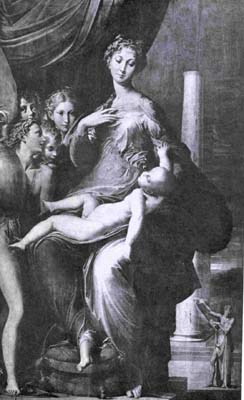
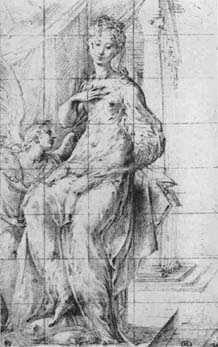

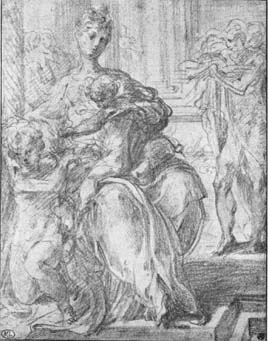
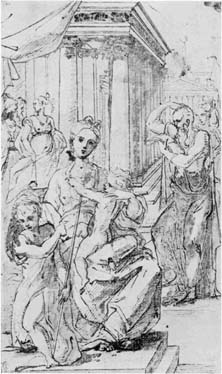
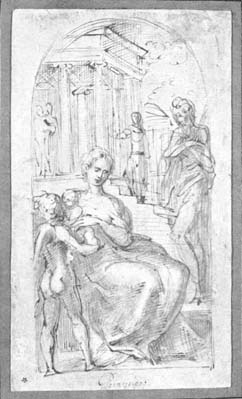
![]()
Two
Drawings by Parmigianino The first of the two drawings by Parmigianino recently acquired
for the National Gallery is a study for the Madonna dal collo
lungo (Fig. I), a picture commissioned from the artist by Elena
Baiardi, widow of Francesco Tagliaferri, on 23 December 1534, for
her chapel in the Chiesa dei Servi di Maria in Parma. He undertook
in the contract (1) to complete the painting by Pentecost of the
following year, but it was not placed on the altar of the chapel
until 1542, after the artist's death and it was still not entirely
finished. It is satisfactory to be in a position to provide definite
information of this character about a drawing but one would also
like to know to what stage in the protracted evolution of the work
the study belonged. There are at least twenty drawings which have
come down to us made in preparation for the picture, (2) and it is a
task of some difficulty to arrange them in the order of their
execution. Indeed it is doubtful whether any certainty on the
subject is attainable, but it seems worth while making the attempt
in the case of a painting of such outstanding importance in the
development of Mannerism as the Madonna dal collo lungo.
by A. E. Popham
Résumé en français
Pages 1 | 2
| 3
In the present context we can, I think, eliminate any
consideration of the background figures of St Jerome and his
companion, for which there are a number of studies, and confine
ourselves to the figures of the Madonna and Child in their general
setting. Nor do I think it necessary to enlarge on my theory that
the Madonna dal collo lungo developed from an earlier
composition, in which the Virgin and Child are represented enthroned
on a pedestal, flanked on the left by St Jerome and on the right by
St Francis, represented by a drawing in the Louvre, (3) though the
resemblance between the large scale St Jerome there and his
diminutive figure in the picture and the various studies for it
seems to me conclusive. I will limit my remarks to the drawings
which are definitely in preparation for the picture as it finally
emerged.
It will, I think, be easiest to see which of these most closely
resembles the picture and, assuming that to have been the last one
drawn, to work backwards. Such a drawing is the red chalk study in
the Louvre (4) (Fig. 2), in which the figure of the Virgin almost
exactly corresponds with her appearance in the picture. The set ting
moreover with the row of columns abruptly foreshortened behind on
the right, the platform and the cushion on which the Virgin rests
her right foot and the angel holding the amphora on the left with
the curtain above his head are almost identical; only his three
companions, as well as the background figure of St Jerome, are
absent and rather surprisingly the Infant Christ Himself (except for
His legs which are lightly sketched in a position which differs
somewhat from that in the picture). A slight sketch, in the Pierpont
Morgan Library, of the headless Virgin with the complete Child on
her lap (5) would seem to have been made as a complement to the
Louvre drawing, as do studies at Budapest of the angel with the
amphora, in which the drapery of the Virgin's right leg and the legs
of the Infant Christ are included. (6) There are other studies of
detail corresponding fairly closely with those in the painting and
with the drawing in the Louvre (Fig. 2): two in the British Museum
for the drapery of the Virgin's bust including her right arm and
hand; (7) for the Virgin's left leg, her right arm and for the body
of the Infant Christ in the Huntington Library (8) and for the Child
alone in the Louvre, (9) though His attitude differs considerably
from that in the picture. One must suppose that Parmigianino had now
reached a stage in the production of the work when he was satisfied
with the general composition, the lines of which may already have
been laid in on the panel, and was carefully working out the details
bit by bit. Curiously enough it seems to have been the figure of the
Infant Christ, to this day not entirely finished, which remained in
a fluid state almost to the last.
In the Louvre drawing (Fig. 2) the Virgin is turned to
the left, places her right hand to her bosom and rests her right
foot on a cushion. These are all essential ingredients of the
painting and of the drawings which we have hitherto considered.
Another arresting feature is the presence on the extreme left,
partly cut off by the edge of the picture, of a well-grown angel
holding a large amphora. (10) In all the other studies for the whole
composition known to me the Virgin is invariably seated with her
body and legs turned to the right. In one of these, also in the
Louvre (11) (Fig. 3) her position corresponds almost exactly with the
picture, but in reverse. Here her left hand touches her bosom in the
same coquettish gesture and her left foot is similarly raised on a
cushion, the architecture of the columned temple is the same and in
the same relative position and there are two purri on the
left, one of whom holds the symbolic amphora. The Child does not
appear at all, but a figure corresponding to that of St Jerome in
the picture is scribbled in. I think it can be assumed that this
little sketch precedes, but not necessarily by a long interval, the
other drawing in the same collection (Fig. 2). Going back still
further, I suppose, we come to two more drawings (Figs. 4 and 5)
both in the Louvre. (12) In these a new element is introduced with
the youthful St John the Baptist, who, kneeling on one knee on the
extreme left in the place of the amphora-carrying angel, points at
the Infant Saviour seated upright on His Mother's lap. His attitude
is a much modified repetition of that of his older counterpart in
the National Gallery Vision of St Jerome. St Jerome himself,
represented on a much larger scale than in the painting of the Madonna
dal collo lungo, is included, as well as the architectural
background, which differs from the later representations in that the
temple is less sharply foreshortened, is placed higher up in the
composition and that other buildings are included. A third drawing
in the Louvre (13) is a partial study of the Madonna and Child in
this version, with St John the Baptist indicated by a few lines and
a separate study of the Virgin 's head and bust.
Now at last we get back to the Ottawa drawing (Fig. 6), which
represents yet another and presumably still earlier idea for the
picture. (14) That it must be a study for this picture is apparent on
comparing it with the second of the two Louvre drawings even though
this is a copy (Fig. 5), but there are remarkable differences. The
attitude of the saint on the right, supposedly St Jerome, differs
from that in any of the other drawings; in the two connected Louvre
drawings in which he appears, he places his right hand on top of his
head in a gesture signifying profound meditation. Here his arms are
crossed over his chest. The temple is raised still higher at the top
of a flight of steps; the composition has an arched top and St John
the Baptist has been replaced by a winged boy angel seen from the
back who either takes the Infant Christ from, or gives Rim back to,
His Mother. I think we may recognize this boy angel in a minute
sketch in the Louvre (15) (Fig. 7), one of five drawings which
Mariette had mounted together on one sheet and which included a
sketch for the St Jerome in the Madonna dal collo lungo.
1 | 2 | 3
Annual Index | Author & Subject | Credits | Contact
This digital collection
was produced under contract to Canada's Digital Collections program,
Industry Canada.
"Digital
Collections Program, Copyright
© National Gallery of
Canada 2001"